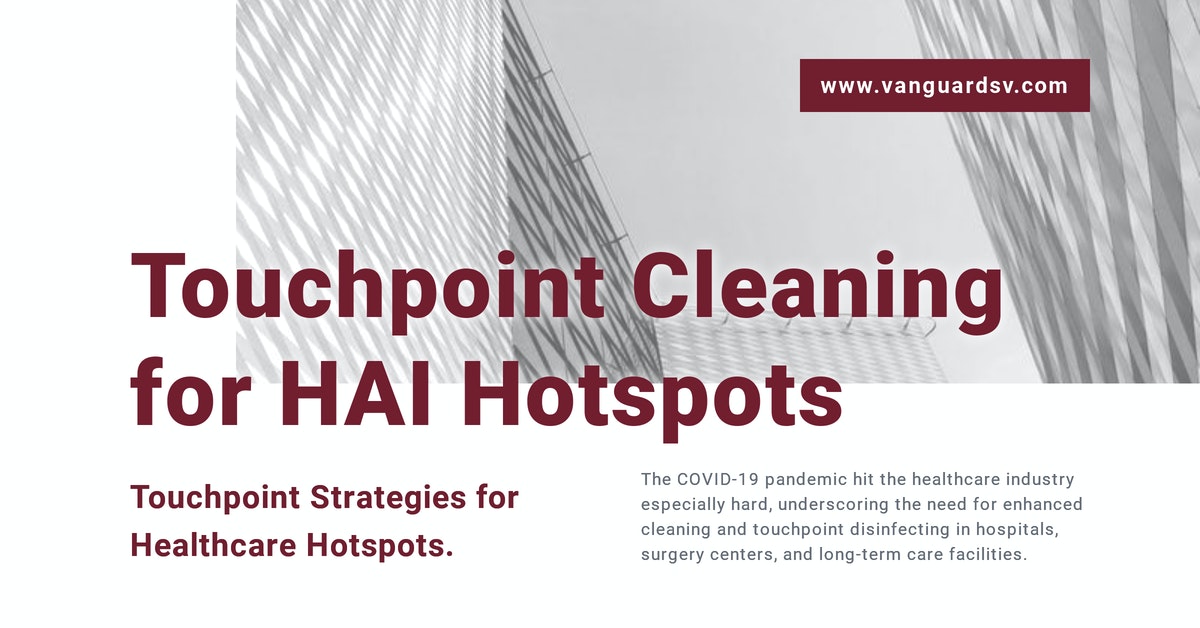The COVID-19 pandemic hit the healthcare industry especially hard, underscoring the need for enhanced cleaning and touchpoint disinfecting in hospitals, surgery centers, and long-term care facilities.

Touchpoint Strategies for Healthcare Hotspots
Prior to the rise of COVID-19 infection, hundreds of thousands of hospital-acquired infections were reported by acute care facilities in the U.S., claiming the lives of tens of thousands of patients.
According to the U.S. Centers for Disease Control and Prevention;
There were an estimated 687,000 HAIs in U.S. acute care hospitals in 2015.
About 72,000 hospital patients with HAIs died during their hospitalizations.
The most common forms of HAI's include:
- C.diff.
- E.coli.
- Influenza.
- Norovirus.
- HIV.
- Hepatitis A, B, and C.
- MRSA.
- Staph, and;
- E.faecalis;
many of which are antibiotic-resistant.
Due to the wide-spread outbreak of COVID-19, healthcare facilities across the country were required to update and modernize their approach to facility cleaning and disinfection, starting with the patient hot zone, especially the bed--areas that reportedly have received disturbingly little attention by responsible cleaning staff in the past.
According to a recent article published by cleaning industry online magazine, CleanLink;
The most important object to clean and disinfect is the bed itself.
This includes providing regular linen changes and disinfecting the mattress and bed frame along with bed controls, remotes, buttons, grab bars and call lights.
Surfaces near the bed may include over-the-bed tables with items like television remotes and phones.
The patient hot zone is the area of most concern in regard to cross-contamination and transfer of infection.
That's where we have the most opportunity for direct patient contact and also the transfer of infection through droplets in the air or surfaces that they're touching.
Despite these risks, studies have shown that only 40 percent of near-patient surfaces are cleaned in accordance with hospital policy — a sign that there is still ample room for improvement.
Cleaning Patient Hot Zones
Patient hot zones should be cleaned in accordance with occupancy and use--at least once per day, preferably hourly during an outbreak or when the room is occupied by a vulnerable patient.
Often, the duties for maintaining the cleanliness and hygiene of various surfaces within a patient room are split between housekeeping staff and the nurses.
A recommended strategy to avoid confusion, cross-contamination, and potential equipment damage is to color code the equipment and various surfaces and thoroughly train custodial and nursing staff on who is responsible for what color code.
Well-known germ hotspots within patient rooms include:
- Computer and other monitoring equipment and technological devices, many of which are regularly moved between rooms.
- Patient beds, especially the rails, and;
- Sinks, faucets, and restroom fixtures and facilities.
Each of these surfaces requires:
- A thorough cleaning to get inside all the nooks and crannies.
- Specialized, surface-appropriate cleaning, and disinfectant products, and;
- Enough downtime to all the disinfectant to remain wet while dwelling on the surface to be adequate.
Other less commonly addressed, but equally problematic surfaces, often referred to as soft surfaces, include:
- Mattresses.
- Chairs and other furniture, and;
- Privacy curtains.
The recommended action is to follow manufacturer labels regarding cleaning and disinfection to maintain the warranty status.
However, this could lead to a rapid breakdown of the material and a significantly reduced life-span, so it is important to monitor cost vs. value and potentially replace some furniture, such as privacy curtains, with a disposable variation.
The most crucial component to success when cleaning and disinfecting patient hot zones is consistency, which can be achieved through:
- Documentation of responsibilities, cleaning, and disinfecting products and labels, and surface care.
- Training, which should include safe product handling and disposal and color-codes for both surfaces and cleaning tools, and;
- Checklists, which should be broken up into zones and departmental responsibility, and include an area where potential issues can be reported and communicated to senior staff.
References & Resources
- Most Common Healthcare-Associated Infections: 25 Bacteria, Viruses Causing HAIs
- Cleaning Hospital Equipment, Bedside Area
- Consistent Protocol Key To Infection Control
Takeaway
Prior to the COVID-19 pandemic, HAI's in various long-term and acute healthcare facilities were a huge problem.
With the rise of COVID-19 infections and the current lack of information regarding how it is spread, patient hot zone cleaning is more critical now than ever before.
Overworked hospital staff and underequipped housekeeping staff are rarely trained and prepared to deal with the level of cleaning and disinfection knowledge and equipment necessary to ensure occupant health and safety.
Outscouring to an experienced service provider is a proven method for cost-effectively onboarding vital sanitation and hygiene surfaces while controlling costs.
If you would like more information regarding the effectiveness of high-performance infection prevention and control measures, or if you would like to schedule a free, no-obligation onsite assessment of your facility's custodial needs, contact us today for a free quote!
In Bakersfield CA, call (661) 437-3253
In Fresno CA, call (559) 206-1059
In Valencia CA, or Santa Clarita CA, call (661) 437-3253
In Palmdale CA, or Lancaster CA, call (661) 371-4756

